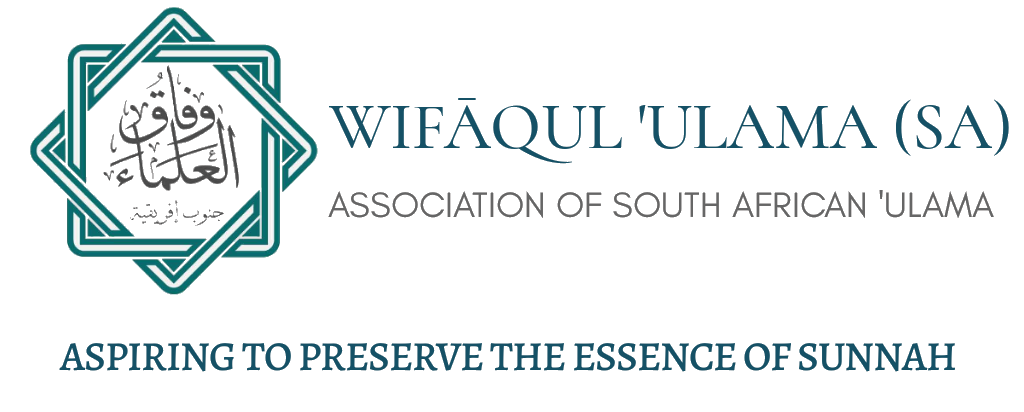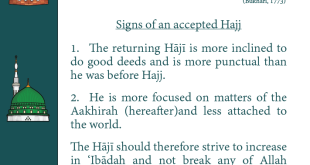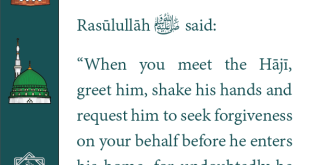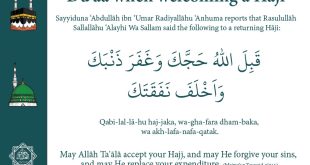The Farewell Hajj – Part 7
Leaving Muzdalifah
As dawn approached, Rasulullah Sallallahu ‘Alayhi Wa Sallam departed Muzdalifah, adhering to his practice of leaving before sunrise. Contrary to the custom of the pre-Islamic era. Rasulullah Sallallahu ‘Alayhi Wa Sallam chose not to delay departure until the sun was visible atop Mount Thabeer, thereby setting a new precedent for the Hajj pilgrimage.
During the journey from Muzdalifah to Mina, Sayyiduna Fadhl bin ‘Abbaas Radiyallahu ‘Anhu joined Rasulullah Sallallahu ‘Alayhi Wa Sallam on his mount, while Hadhrat Usamah Radiyallahu ‘Anhu travelled on foot. Both narrated that Rasulullah Sallallahu ‘Alayhi Wa Sallam did not stop reciting the Talbiyah until he pelted the Jamarah of ‘Aqabah. (Sahih Bukhari, Hadith 1602, Pg. 605)
It was on the same route that Fadhl Ibn ‘Abbaas Radiyallahu ‘Anhu was instructed to collect the pebbles for the pelting of the Jamaraat, and it was on the same route that a woman from the tribe of Khas’am approached Rasulullah Sallallahu ‘Alayhi Wa Sallam. While this discussion was taking place, Fadhl Ibn ‘Abbaas Radiyallahu ‘Anhu was looking at her, and she was looking at him. Rasulullah Sallallahu ‘Alayhi Wa Sallam turned the face of Fadhl Ibn ‘Abbaas Radiyallahu ‘Anhu away so they do not look at each other.
The valley of Muhassar
As Rasulullah Sallallahu ‘Alayhi Wa Sallam traversed the valley of Muhassar, he hastened his camel forward. Situated between Mina and Muzdalifa, Muhassar is neither part of Mina nor Muzdalifa. It was commonly believed to be a site of divine retribution, where the army of the elephant was destroyed.
Upon reaching Mina, Rasulullah Sallallahu ‘Alayhi Wa Sallam first approached the Jamarah of ‘Aqabah, riding his camel with determination. As the sun ascended, he faced the Jamarah of ‘Aqabah and commenced the ritual of stoning, proclaiming Takbeer with each pebble cast. With the Ka’bah on his left and Mina on his right, he continued the stoning ritual. Until the first pebble of Rami was thrown, he kept reciting the Talbiyah. (Sahih Al Muslim Hadith No. 1296, Pg 512)
The Khutbah of Mina
Returning to Mina, Rasulullah Sallallahu ‘Alayhi Wa Sallam delivered a profound sermon. He emphasized that one another’s blood, wealth, and properties are sacred. Rasulullah Sallallahu ‘Alayhi Wa Sallam mentioned the false messiah, Dajjal and emphasized accountability for one’s deeds, cautioning against straying from the right path after his departure. Rasulullah Sallallahu ‘Alayhi Wa Sallam imparted other advices and reminded the people of their responsibilities and urged them to convey his message to others.
He then addressed the congregation, bidding farewell, recognizing that this would be his final gathering of such a magnitude. Rasulullah Sallallahu ‘Alayhi Wa Sallam knew that this would be his farewell Hajj as Surah Nasr was revealed unto him during the days of Tashreeq, which indicated his departure from this world.
This Hajj is also known as Hajjatul Balagh, as Rasulullah Sallallahu ‘Alayhi Wa Sallam asked, ‘Did I convey the message of Deen unto you?’ It is also known as Hajjatul Islam, as for the first time, everyone who performed Hajj were adherents of Islam and there was not one disbeliever or idolater amongst the congregation. Lastly, another title of this Hajj is ‘Hajjatul Kamaal’ due to the proclamation of the completion and perfection of Deen.
Staying in Mina and the slaughter of Hajj
At Mina, Rasulullah Sallallahu ‘Alayhi Wa Sallam performed the sacrificial rites of Hajj, slaughtering sixty-three camels, as per the number of years of his blessed life, with his own hands, accompanied by Hadhrat ‘Ali Radiyallahu ‘Anhu who brought additional camels. Rasulullah Sallallahu ‘Alayhi Wa Sallam slaughtered the same 63 camels he brought along from Madinah, and Hadhrat ‘Ali Radiyallahu ‘Anhu slaughtered the rest that he brought from Yemen, thus making it 100 in total. (Sunan Tirmizi, Hadith 815. Pg. 153)
Rasulullah Sallallahu ‘Alayhi Wa Sallam permitted the meat of the sacrificial animals to be consumed. (Bukhari, Hadith 1632, Pg. 614)
Staying In Mina and shaving the head
After completing the sacrificial rites, Rasulullah Sallallahu ‘Alayhi Wa Sallam called for a barber who then shaved the blessed head of Rasulullah Sallallahu ‘Alayhi Wa Sallam trimmed his nails and removed the hair surrounding his blessed lips and on his blessed cheeks. Thereafter, Rasulullah Sallallahu ‘Alayhi Wa Sallam divided the hair, giving one side to Hadhrat Abu Talha Radiyallahu ‘Anhu exclusively and instructing the distribution of the other side among the gathered people. (Sahih Muslim, Hadith 1305, pg. 514)
Furthermore, Rasulullah Sallallahu ‘Alayhi Wa Sallam supplicated thrice for those who shave their heads and once for those who only trim their hair.
 Wifāq ul Ulāma (SA) ASSOCIATION OF SOUTH AFRICAN 'ULAMA
Wifāq ul Ulāma (SA) ASSOCIATION OF SOUTH AFRICAN 'ULAMA


